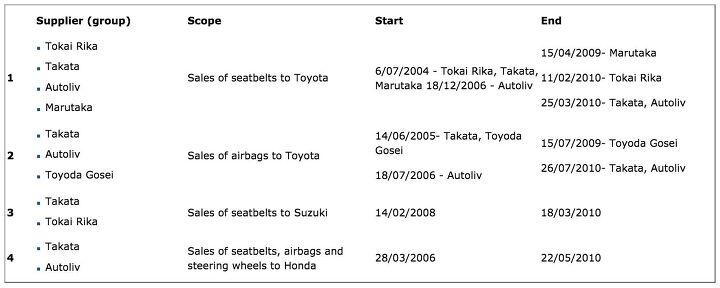Car, Tell: Quintet of Safety Suppliers Fined for Price Fixing

It appears the fictional JR Ewing isn’t the only one having to deal with cartels. Antitrust regulators in the EU have fined five safety equipment suppliers a combined 34 million euros ($40 million) for taking part in a scheme to fix prices for seat belts and airbags sold to Japanese automakers.
The cartels were allegedly supplying the safety equipment to Toyota, Suzuki, and Honda at inflated prices between calendar years 2004 and 2010.
Reuters reports an investigation spanning the last six years began with raids of facilities associated with the cartels in June 2011, culminating in the fines levied with this decision.
Penalties to the individual companies range from 156,000 euros to 12.7 million euros. The largest amount was levied at a company already well known for causing headaches to manufacturers who used its safety products: Takata.
Takata, the supplier of millions of airbags that seemed to do more harm than good, filed for bankruptcy earlier this year. The total global liabilities the supplier has to endure is well into the billions. A research company in Tokyo claims Takata’s total liabilities for ongoing recalls, penalties, and settlements is likely somewhere in the neighborhood of $15 billion. What’s another few million tossed on top of that, then?
However, according to the Commission report, Takata received full immunity for revealing three of the cartels (thereby avoiding an aggregate fine of approximately 74 million euros.
Commissioner Margrethe Vestager, in charge of competition policy said: “The five suppliers fined today colluded to maximise their profits from the sale of these components. This may have raised the costs of these car parts for a number of manufacturers selling cars in Europe, potentially affecting consumers.” Fixing the prices of anything is shady; teaming up to make extra coin on important safety equipment is even shadier.
The Commission’s investigation revealed the existence of four separate infringements. The following table details the participation and the duration of each company’s involvement in each of the four infringements:
Regulatory bodies are seeming to be cracking down on this type of nefarious activity with newfound force. Witness the raid on Daimler and BMW offices this past summer, carried out on suspicion there was a conspiracy to fix prices in diesel and other technologies. Companies which fudge fuel economy numbers have also come under the microscope.

Matthew buys, sells, fixes, & races cars. As a human index of auto & auction knowledge, he is fond of making money and offering loud opinions.
More by Matthew Guy
Latest Car Reviews
Read moreLatest Product Reviews
Read moreRecent Comments
- Ollicat Another Biden attempt to say, "Look over there!"
- Kjhkjlhkjhkljh kljhjkhjklhkjh Who cares. Price of gas is not the issue. spending an extra 100$ a month over 4 tanks of gas is not the issue.this a political scam to distract really dumb people from the real issue. if rent and house payments were not up by 50% to as high as 150% higher in a ton of locations, then paying an extra 100$ in gas would be annoying but not really an issue. But the real-estate market with hedge fund investors, power-relator groups bought a ton of houses and flipped them into rentals and jacked up the rates uplifting the costs on everything else. and ironically no-one seems to be in any hurry to build more houses to bring those costs down because supply and demand means keeping less houses available to charge as much as you want. It is also not the issue as a secondary issue is child care costs and medical... again 100$ extra per month in gas is *nothing* compared to 800$ a month in ''child care'' and 300$ per visit to the doctor office, 300$ for a procedure less dentist trip..
- Ajla Is there something proprietary or installed on the moon with these that I'm not aware of?
- Tane94 Awaiting the EV3 unveil this month. Kia continues to lead, though I will miss the Soul
- Jeanbaptiste I know this will never be seen, but the real answer is NO Government mandated tech. The reason why is that when the government mandates something, we miss out on signals that the free market will give to weather or not people actually want this or that this tech would actually help. It's like mandating AM radio for cars when people could just buy a $10 am radio if they really like am so much.


































Comments
Join the conversation
You have to pay extra for Japanese reliability, even in Europe.